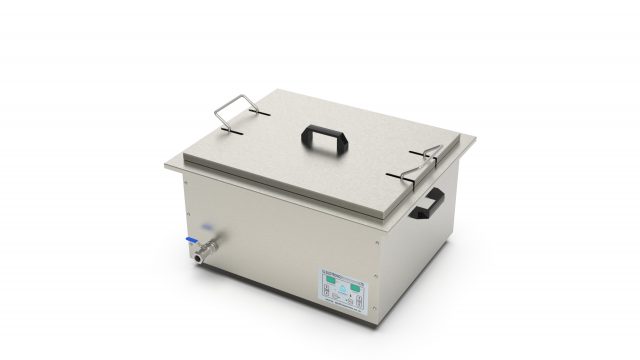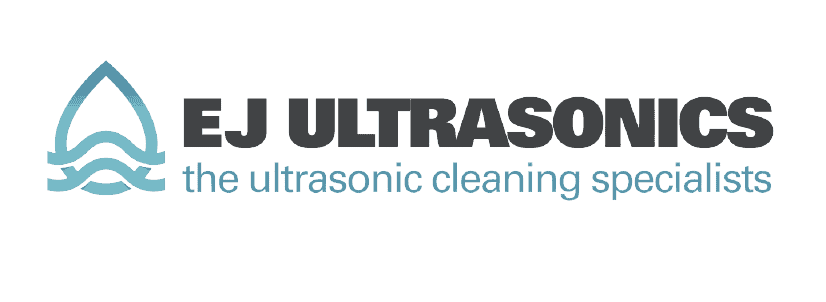Industrial ultrasonic cleaning has revolutionised formerly labour-intensive cleaning processes across a range of industries. Ultrasonic technology provides a robust, efficient and environmentally friendly way to clean everything from large aerospace parts to the most delicate contact lenses, changing the way thousands of sectors approach their cleaning tasks.
Here at EJ Ultrasonics, we’ve been advocating the use of ultrasonic cleaning for over 25 years, not only working with existing technology but innovating in the field of ultrasonics and creating new and improved bespoke machines for many different industries.
This comprehensive guide from the EJ Ultrasonics engineers will help you delve deeper into the mechanics of industrial ultrasonic cleaning, its myriad applications and its numerous benefits.

Understanding the industrial ultrasonic cleaning process
Ultrasonic cleaning is a method that uses ultrasonic waves and a suitable cleaning solution – or even water – to clean items of many different sizes meticulously. The process involves the creation of microscopic bubbles through a phenomenon known as cavitation. The bubbles produced then implode, creating intense pressure changes that dislodge contaminants from the surfaces of the items being cleaned.
Industrial ultrasonic cleaners, including large industrial ultrasonic cleaners, play a crucial role in this process, embracing how size-oriented ultrasonic cleaning can be used in different businesses. While it’s easy to assume that “industrial” means large in size, it’s the task these units must perform that defines them as industrial. Industrial ultrasonic cleaners can range from bench and tabletop units to multi-litre, multi-stage floor-mounted units. In short, the underlying connecting factor is their function, not their form.
Decoding the complexities of ultrasonic cleaning
Each ultrasonic cleaning unit, while operating on the same fundamental principle, can vastly differ in its performance based on a few key parameters. Understanding these parameters can help you choose the right industrial ultrasonic cleaning unit for your specific needs.
Ultrasonic frequency
Ultrasonic frequency refers to the sound waves that the unit uses to clean items. The frequency range can have a significant impact on the cleaning results. Most ultrasonic cleaners operate between 35 and 45 kHz, a frequency range that suits the vast majority of cleaning tasks.
However, specific tasks and industries may require higher or lower frequencies. For instance, a lower frequency such as 25 kHz produces larger cavitation bubbles, releasing a larger amount of cleaning energy and thus more suitable for coarse cleaning tasks like removing heavy grease or even stubborn rust. On the other hand, a higher ultrasonic cleaning frequency produces smaller cavitation bubbles, making it gentler and more suitable for fine cleaning more delicate items like optical equipment or electronic components.
Ultrasonic cleaning solution
Choosing the right cleaning solution is as crucial as selecting the right ultrasonic frequency. Most of today’s cleaning solutions are biodegradable, significantly reducing their environmental impact. These cleaning solutions are designed to work efficiently with specific types of contamination, enhancing the cleaning process. The EJ Ultrasonics experts can advise you on the best solution to use for your particular needs and industry once you’ve found the right ultrasonic cleaning machine.
Tank dimensions and working depth
The tank dimensions of your ultrasonic cleaning unit are a crucial aspect to consider, especially regarding the size of the items to be cleaned. For effective cleaning, items must be fully immersed in the cleaning solution. Hence, it’s necessary to measure the dimensions of the largest parts you plan to clean and select equipment with a tank that can accommodate them.
Baskets and cleaning efficiency
In the context of industrial ultrasonic cleaning, baskets play a crucial role, especially when cleaning smaller parts. Baskets help support the parts in an industrial ultrasonic cleaner, protect tanks from possible damage from the parts, and enhance cleaning efficiency.
The green impact of ultrasonic industrial cleaning equipment
Industrial ultrasonic cleaning is not just about efficiency and power, it’s also about being environmentally responsible. The use of biodegradable cleaning solutions is one way that ultrasonic cleaners minimise their environmental impact. Moreover, these machines are water-efficient, using less water than traditional cleaning methods while achieving superior cleaning results. The low thermal energy consumption of ultrasonic cleaners is another environmental advantage. These machines often operate at lower temperatures than conventional cleaning systems, reducing energy consumption.
Industrial applications of ultrasonic cleaning
Ultrasonic cleaning has broad applications across various industries. This technology is used to clean a range of items, from delicate electronic parts to large engine components.
In the automotive industry, for example, ultrasonic cleaners can remove tough grime and dirt from car parts such as fuel injectors, carburettors and engine components. The precision cleaning provided by the ultrasonic process helps to restore parts to their original condition, improving their performance and extending their lifespan.
In the aerospace industry, ultrasonic cleaning is used to ensure critical components are clean and free of contaminants that could compromise the safety and performance of aircraft. Components such as turbine blades, fuel nozzles and other parts can be cleaned effectively using ultrasonic technology, maintaining the highest standards of cleanliness and safety.
In electronics manufacturing, delicate components like printed circuit boards (PCBs) can be cleaned efficiently and safely using ultrasonic technology. The gentle cleaning process ensures that sensitive electronic components are not damaged, improving product quality and reliability.
Embracing industrial ultrasonic cleaning
Industrial ultrasonic cleaning is a revolutionary approach to cleaning in various industries. Its applications are vast, its results impressive, and its environmental footprint is minimal. Given its many benefits and uses, industrial ultrasonic cleaning is undoubtedly a smart investment in your operation’s future. Its potential to increase efficiency, enhance product quality, and reduce environmental impact makes it an excellent choice for any business looking for a powerful and sustainable cleaning solution.
Striving to remain at the forefront of ultrasonic cleaning technology, at EJ Ultrasonics we continually invest in development and expand our range of products. This relentless drive for innovation ensures our ultrasonic cleaning systems are equipped to handle any type of application.
EJ Ultrasonics – leaders in industrial ultrasonic cleaners
If you’re looking for an efficient way to precision clean your components without resorting to harmful chemicals or solvents, EJ Ultrasonics has the answer. Our ultrasonic cleaning systems are not only reliable and environmentally friendly, but they’re also extraordinarily effective. By automating the cleaning process, they significantly reduce manual labour, allowing your workforce to concentrate their efforts and skills in other areas.
By allowing us to help you make the right choices based on your specific requirements and conditions, you can harness the full potential of this technology, ensuring your components are immaculately cleaned and ready for use. Whether you’re looking for a large industrial ultrasonic cleaner or a more compact ultrasonic cleaning unit, your ideal solution is out there.
Enquire today for assistance from the experts – call 01527 831 678, email info@ejultrasonics.co.uk or use our online form.


